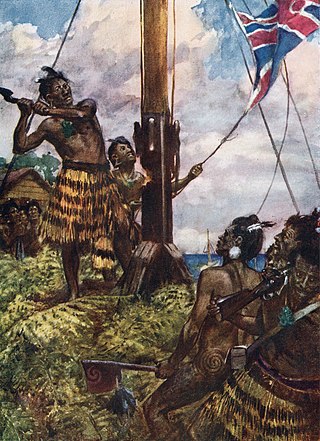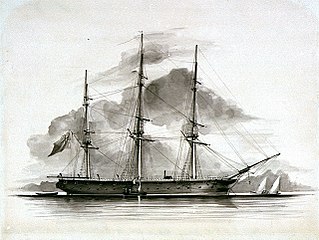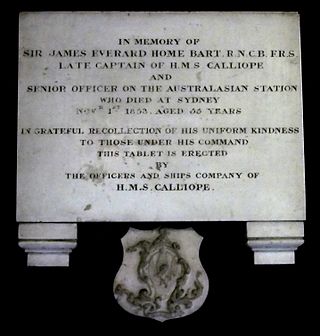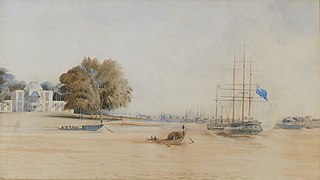
The Flagstaff War, also known as Heke's War, Hōne Heke's Rebellion and the Northern War, was fought between 11 March 1845 and 11 January 1846 in and around the Bay of Islands, New Zealand. The conflict is best remembered for the actions of Hōne Heke who challenged the authority of the British by cutting down the flagstaff on Flagstaff Hill at Kororāreka. The flagstaff had been a gift from Hōne Heke to James Busby, the first British Resident. The Northern War involved many major actions, including the Battle of Kororāreka on 11 March 1845, the Battle of Puketutu on 8 May 1845, the Battle of Ōhaeawai on 23 June 1845 and the siege of Ruapekapeka Pā from 27 December 1845 to 11 January 1846.

HMS Rattlesnake was an Atholl-class 28-gun sixth-rate corvette of the Royal Navy launched in 1822. She made a historic voyage of discovery to the Cape York and Torres Strait areas of northern Australia.

HMS Terror was a specialised warship and a newly developed bomb vessel constructed for the Royal Navy in 1813. She participated in several battles of the War of 1812, including the Battle of Baltimore with the bombardment of Fort McHenry. She was converted into a polar exploration ship two decades later, and participated in George Back's Arctic expedition of 1836–1837, the successful Ross expedition to the Antarctic of 1839 to 1843, and Sir John Franklin's ill-fated attempt to force the Northwest Passage in 1845, during which she was lost with all hands along with HMS Erebus.

HMS Griper was a Bold-class gun-brig of the British Royal Navy, built in 1813 by Mark Williams and John Davidson at Hythe. She participated in the 1819 expedition to the Arctic led by William Parry, made a voyage to Greenland and Norway in 1823, and took part in Parry's third expedition in 1824 as a support ship. Her crew in 1819, 1823, or 1824, qualified for the "Arctic Medal", which the Admiralty issued in 1857. She was eventually broken up in 1868.

Lieutenant Colonel William Hulme was an officer of the 96th Regiment of Foot, British Army.
North Star Bay, also known as Thule Harbor and Wolstenholme Bay, is a bay off the mouth of Wolstenholme Fjord, Greenland.

HMS Ardent was a wooden Alecto-class paddle sloop, and the fourth ship of the Royal Navy to use the name. She was launched on 12 February 1841 at Chatham and spent much of her career on the West Coast of Africa engaged in anti-slavery operations. One of the ship's company, Gunner John Robarts, was awarded the Victoria Cross for the destruction of Russian food stores in the Crimean War. She was scrapped in 1865.
HMS Castor, launched and commissioned in 1832, was a 36-gun fifth rate frigate of the Royal Navy and the third naval ship to bear the name.

The Cruizer class was a class of six 17-gun wooden screw sloops built for the Royal Navy between 1852 and 1856.
HMS Hazard was an 18-gun Favorite-class sloop of the Royal Navy. She was one of four Favorite-class ship sloops, which were a ship-rigged and lengthened version of the 1796 Cruizer-class brig-sloop. All four ships of the class were ordered on 10 June 1823. She was launched in 1837 from Portsmouth Dockyard.

HMS Niger was originally slated to be built as a Sampson designed sloop; however, she was ordered as a First-Class sloop with screw propulsion on 20 February 1845 to be built at Woolwich Dockyard, along the design developed by Oliver Lang and with a hull like the Basilisk designed paddle sloops. Her armament and engine were to be like the Encounter Design building at Pembroke. A second vessel (Florentia) was ordered on 26 March 1846 but after her keel was laid at Pembroke Dockyard, her construction was suspended on 6 October 1846 then cancelled three years later, on 22 May 1849. Niger She conducted important propulsion trials, finally proving the superiority of screw propulsion and served in West Africa, the Crimea, China, the East Indies and Australia. She took part in the New Zealand wars in 1860 and was sold for breaking in 1869.

HMS Brisk was a 14-gun wooden-hulled screw sloop designed by the Committee of Reference as part of the 1847 program. She is considered an enlarged Rattler with the design approved in 1847. She was ordered on 25 April 1847 from Woolwich Dockyard as a 10-gun sloop, but the guns were later increased due to the Russian War, to 14 guns by increasing the number of 32-pounder guns. She was launched on 2 June 1851 from Woolwich Dockyard. She served in the Russian War of 1854- 55 and as part of the Southern African anti-slavery patrol, with a final commission on the Australian Station. She was sold in 1870 for use in an pioneer, but unsuccessful, telegraph service.

HMS Herald was an Atholl-class 28-gun sixth-rate corvette of the Royal Navy. She was launched in 1822 as HMS Termagant, commissioned in 1824 as HMS Herald and converted to a survey ship in 1845. After serving as a chapel ship from 1861, she was sold for breaking in 1862.

Captain Sir James Everard Home, 2nd Baronet,, born at Well Manor, Hampshire, England, was an eminent nineteenth century Royal Navy officer.

HMS Calliope was a 28-gun sixth rate launched in October 1837 and broken up in November 1883.

Pōmare II, originally named Whiria, was a Māori rangatira (chief) of the Ngāpuhi iwi (tribe) in New Zealand and the leader of the Ngāti Manu hapu (subtribe) of the Ngāpuhi. He was the nephew of Pōmare I, his mother Haki being the elder sister of Pōmare I. When he succeeded his uncle as leader of the Ngāti Manu he took his uncle's names, Whētoi and Pōmare. He is referred to as Pōmare II, so as to distinguish him from his uncle.

Sir Edward Hughes was launched in 1784 as an East Indiaman for the British East India Company (EIC). She spent four years as a country ship, i.e., sailing in the East Indies but without going to Britain. Then between 1788 and 1803 she made eight voyages to India and China for the EIC. In 1804 the EIC sold Sir Edward Hughes to the British Royal Navy, which commissioned her as a 38-gun frigate. The Navy renamed her Tortoise in 1807 and converted her to a storeship in 1808. After the end of the Napoleonic Wars she became variously a coal depot, a hulk, and then a convict transport. In 1844 she became a receiving ship at Ascension Island. She was lost there in 1859, or broken up there in 1860, or 1863.

HMS Seringapatam was a 46-gun Seringapatam-class fifth-rate frigate built for the Royal Navy between 1817 and 1821, the name ship of her class.
HMS Inflexible was a Bulldog-class sloop designed by Sir William Symonds, Surveyor of the Navy. Originally she was ordered as a Driver-class sloop, however, under Admiralty Order of 26 December 1843 she was directed to be built to a new specification. After commissioning she sailed for the East Indies and participated in the last year of the New Zealand War of 1845 to 1847. She then was in the Black Sea for the Russian War followed by the Second Opium War with China. She was sold for breaking in July 1864.

The Battle of Puketutu was an engagement that took place on 8 May 1845 between British forces, under the command of Lieutenant Colonel William Hulme, and Māori warriors, led by Hōne Heke and Te Ruki Kawiti, during the Flagstaff War in the Bay of Islands region of New Zealand.


















